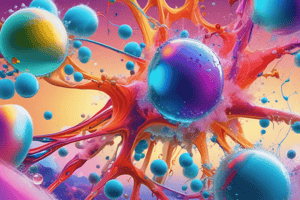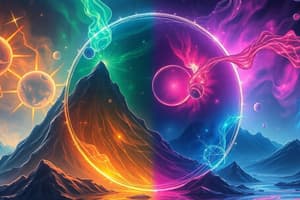Podcast
Questions and Answers
What is the process called when a solid turns into a liquid upon heating?
What is the process called when a solid turns into a liquid upon heating?
Melting (or Fusion)
What happens to the kinetic energy of particles during the freezing process?
What happens to the kinetic energy of particles during the freezing process?
The kinetic energy decreases.
How does evaporation differ from boiling?
How does evaporation differ from boiling?
Evaporation occurs at temperatures below the boiling point, while boiling occurs at the boiling point.
What role does temperature play in the melting process?
What role does temperature play in the melting process?
Can the freezing point and melting point be the same for a substance? If so, explain.
Can the freezing point and melting point be the same for a substance? If so, explain.
What factors can affect the rate of evaporation?
What factors can affect the rate of evaporation?
Describe the mechanism involved in boiling.
Describe the mechanism involved in boiling.
What is the term for the process when a liquid solidifies into a solid?
What is the term for the process when a liquid solidifies into a solid?
What is condensation, and under what conditions does it occur?
What is condensation, and under what conditions does it occur?
Describe sublimation and provide an example of a substance that undergoes this process.
Describe sublimation and provide an example of a substance that undergoes this process.
What occurs during deposition, and how is it different from condensation?
What occurs during deposition, and how is it different from condensation?
Explain the mechanism of condensation in terms of molecular activity.
Explain the mechanism of condensation in terms of molecular activity.
Differentiate between evaporation and condensation in terms of the phases they represent.
Differentiate between evaporation and condensation in terms of the phases they represent.
Identify the phase change that occurs when frost forms on a cold surface and describe the conditions necessary for this process.
Identify the phase change that occurs when frost forms on a cold surface and describe the conditions necessary for this process.
Flashcards are hidden until you start studying
Study Notes
Interconversion of States of Matter
- Matter transitions between solid, liquid, gas, and plasma states due to changes in temperature and pressure.
- Key processes of interconversion include melting, freezing, evaporation, boiling, condensation, sublimation, and deposition.
Detailed Processes
-
Melting (Fusion):
- Solid to liquid transformation occurs at the melting point (e.g., ice melts at 0°C).
- Heating increases the kinetic energy of solid particles, overcoming intermolecular forces, resulting in a liquid state.
-
Freezing (Solidification):
- Liquid to solid transformation occurs at the freezing point (same as melting point).
- Cooling decreases particle kinetic energy, causing them to move closer together and form a solid structure.
-
Evaporation:
- Liquid turns into gas below boiling point, primarily at the liquid surface.
- Surface molecules gain energy to escape into vapor; factors such as temperature, surface area, and air movement influence evaporation rate.
-
Boiling:
- Rapid liquid-to-gas transition at the boiling point.
- Bubbles of vapor form within the liquid and rise to the surface, contrasting with evaporation that occurs only at the surface.
-
Condensation:
- Gas transforms into liquid upon cooling when temperature drops below the condensation point.
- Gas molecules lose kinetic energy, leading them to come closer and form a liquid state, visible as water droplets on cold surfaces.
-
Sublimation:
- Direct transition from solid to gas without liquid phase, examples include dry ice (solid CO₂) and iodine.
- Solid absorbs enough energy causing particles to gain kinetic energy, breaking free into gas phase.
-
Deposition:
- Gas transforms directly into solid without becoming liquid, commonly seen in frost formation.
- Gas molecules lose energy and transition directly into solid state often under conditions of high humidity and low temperatures.
Summary of Processes
- Melting: Solid to liquid (ice to water).
- Freezing: Liquid to solid (water to ice).
- Evaporation: Liquid to gas (water to steam).
- Condensation: Gas to liquid (steam to water).
- Sublimation: Solid to gas (dry ice to gas).
- Deposition: Gas to solid (formation of frost).
Studying That Suits You
Use AI to generate personalized quizzes and flashcards to suit your learning preferences.



